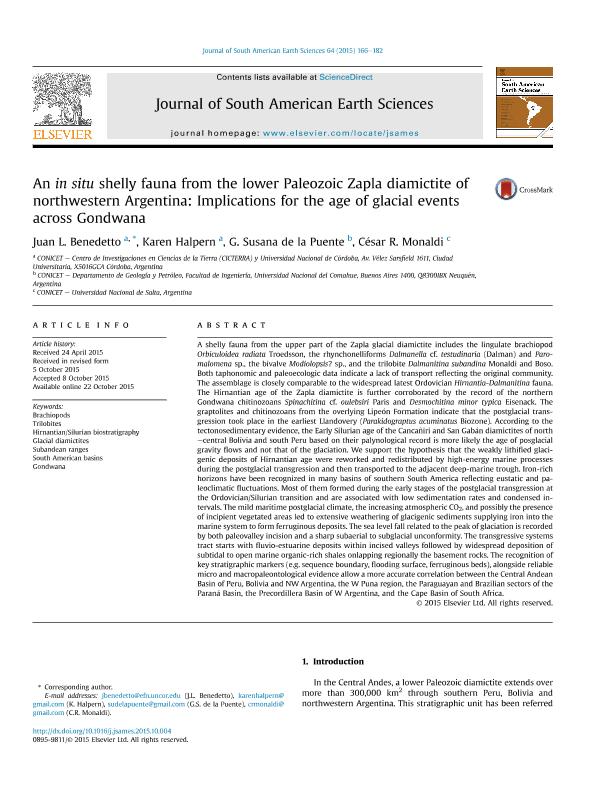Mostrar el registro sencillo del ítem
dc.contributor.author
Benedetto, Juan Luis Arnaldo

dc.contributor.author
Halpern, Karen

dc.contributor.author
de la Puente, Graciela Susana

dc.contributor.author
Monaldi, Cesar Ruben

dc.date.available
2018-04-24T19:49:38Z
dc.date.issued
2015-06
dc.identifier.citation
Benedetto, Juan Luis Arnaldo; Halpern, Karen; de la Puente, Graciela Susana; Monaldi, Cesar Ruben; An in situ shelly fauna from the lower Paleozoic Zapla diamictite of northwestern Argentina: implications for the age of glacial events across Gondwana; Pergamon-Elsevier Science Ltd; Journal of South American Earth Sciences; 64; 1; 6-2015; 166-182
dc.identifier.issn
0895-9811
dc.identifier.uri
http://hdl.handle.net/11336/43328
dc.description.abstract
A shelly fauna from the upper part of the Zapla glacial diamictite includes thelingulate brachiopod Orbiculoidea radiata Troedsson, the rhynchonelliforms Dalmanella cf. testudinaria (Dalman) and Paromalomena sp., the bivalve Modiolopsis? sp., and the trilobite Dalmanitina subandina Monaldi and Boso. Both taphonomic and paleoecologic data indicate a lack of transport reflecting the original community. The assemblage is closely comparable to the widespread latest Ordovician Hirnantia-Dalmanitina fauna. The Hirnantian age of the Zapla diamictite is further corroborated by the record of the northern Gondwana chitinozoans Spinachitina cf. oulebsiri Paris and Desmochitina minor typicaEisenack. The graptolites and chitinozoans from the overlying Lipeón Formation indicate that the postglacial transgression took place in the earliest Llandovery (P. acuminatus Biozone). According to the tectonosedimentary evidence, the Early Silurian age of the Cancañiri and San Gabán diamictites of north-central Bolivia and south Peru based on their palynological record is more likely the age of posglacial gravity flows and not that of the glaciation. We support the hypothesis that the weakly lithified glacigenic deposits ofHirnantian age were reworked and redistributed by high-energy marine processes during the postglacial transgression and then transported to the adjacent deep-marine trough. Ironrich horizons have been recognized in many basins of southern South America reflecting eustatic and paleoclimatic fluctuations. Most of them formed during the early stages of the postglacial transgression at the Ordovician/Silurian transition and are associated with low sedimentation rates and condensed intervals. The mild maritime postglacial climate, the increasing atmospheric CO2, and possibly the presence of incipient vegetated areas led toextensive weathering of glacigenic sediments supplying iron into the marine system to form ferruginous deposits. The sea level fall related to the peak of glaciation is recorded by both paleovalley incision and a sharp subaerial to subglacial unconformity. The transgressive systems tract starts with fluvio-estuarine deposits within incised valleys followed by widespread deposition of subtidal to open marine organic-rich shales onlapping regionally the basement rocks. The recognition of key stratigraphic markers (e.g. sequence boundary, flooding surface, ferruginous beds), alongside reliable micro and macropaleontological evidence allow a more accurate correlation between the Central Andean Basin of Peru, Bolivia and NW Argentina, the W Puna region, the Paraguayan and Brazilian sectors of the Paraná Basin, the Precordillera Basin of W Argentina, and the Cape Basin of South Africa.
dc.format
application/pdf
dc.language.iso
eng
dc.publisher
Pergamon-Elsevier Science Ltd

dc.rights
info:eu-repo/semantics/openAccess
dc.rights
Atribución-NoComercial-CompartirIgual 2.5 Argentina (CC BY-NC-SA 2.5 AR)
dc.rights.uri
https://creativecommons.org/licenses/by-nc-sa/2.5/ar/
dc.subject
Brachiopods
dc.subject
Trilobites
dc.subject
Hirnantian/Silurian Biostratigraphy
dc.subject
Glacial Diamictites
dc.subject
Subandean Ranges
dc.subject
South American Basins
dc.subject
Gondwana
dc.subject.classification
Meteorología y Ciencias Atmosféricas

dc.subject.classification
Ciencias de la Tierra y relacionadas con el Medio Ambiente

dc.subject.classification
CIENCIAS NATURALES Y EXACTAS

dc.subject.classification
Meteorología y Ciencias Atmosféricas

dc.subject.classification
Ciencias de la Tierra y relacionadas con el Medio Ambiente

dc.subject.classification
CIENCIAS NATURALES Y EXACTAS

dc.title
An in situ shelly fauna from the lower Paleozoic Zapla diamictite of northwestern Argentina: implications for the age of glacial events across Gondwana
dc.type
info:eu-repo/semantics/article
dc.type
info:ar-repo/semantics/artículo
dc.type
info:eu-repo/semantics/publishedVersion
dc.date.updated
2018-04-17T16:42:11Z
dc.journal.volume
64
dc.journal.number
1
dc.journal.pagination
166-182
dc.journal.pais
Estados Unidos

dc.description.fil
Fil: Benedetto, Juan Luis Arnaldo. Consejo Nacional de Investigaciones Científicas y Técnicas. Centro Científico Tecnológico Conicet - Córdoba. Centro de Investigaciones en Ciencias de la Tierra. Universidad Nacional de Córdoba. Facultad de Ciencias Exactas Físicas y Naturales. Centro de Investigaciones en Ciencias de la Tierra; Argentina
dc.description.fil
Fil: Halpern, Karen. Consejo Nacional de Investigaciones Científicas y Técnicas. Centro Científico Tecnológico Conicet - Córdoba. Centro de Investigaciones en Ciencias de la Tierra. Universidad Nacional de Córdoba. Facultad de Ciencias Exactas Físicas y Naturales. Centro de Investigaciones en Ciencias de la Tierra; Argentina
dc.description.fil
Fil: de la Puente, Graciela Susana. Universidad Nacional del Comahue. Facultad de Ingeniería. Departamento de Geología y Petróleo; Argentina
dc.description.fil
Fil: Monaldi, Cesar Ruben. Universidad Nacional de Salta. Facultad de Ciencias Naturales; Argentina
dc.journal.title
Journal of South American Earth Sciences

dc.relation.alternativeid
info:eu-repo/semantics/altIdentifier/url/https://www.sciencedirect.com/science/article/pii/S0895981115300699
dc.relation.alternativeid
info:eu-repo/semantics/altIdentifier/doi/http://dx.doi.org/10.1016/j.jsames.2015.10.004
Archivos asociados
